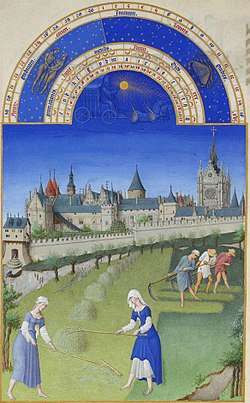June
June is the sixth month of the year in the Julian and Gregorian calendars, the second of four months to have a length of 30 days, and the third of five months to have a length of less than 31 days. June contains the summer solstice in the Northern Hemisphere, the day with the most daylight hours, and the winter solstice in the Southern Hemisphere, the day with the fewest daylight hours (excluding polar regions in both cases). June in the Northern Hemisphere is the seasonal equivalent to December in the Southern Hemisphere and vice versa. In the Northern Hemisphere, the beginning of the traditional astronomical summer is 21 June (meteorological summer begins on 1 June). In the Southern Hemisphere, meteorological winter begins on 1 June.[1]
| << | June | >> | ||||
|---|---|---|---|---|---|---|
| Su | Mo | Tu | We | Th | Fr | Sa |
| 1 | 2 | 3 | 4 | 5 | 6 | |
| 7 | 8 | 9 | 10 | 11 | 12 | 13 |
| 14 | 15 | 16 | 17 | 18 | 19 | 20 |
| 21 | 22 | 23 | 24 | 25 | 26 | 27 |
| 28 | 29 | 30 | ||||
| 2020 | ||||||
No month starts on the same day of the week as June in any year. This month and May are the only two months to have this property. It ends on the same day of the week as March in all years. It starts on the same day of the week as February of the following year. In common years, it begins on the same day of the week as September and December of the previous year and, in leap years, April and July of the previous year. In common years, June ends on the same day of the week as September of the previous year and in leap years, it ends on the same day of the week as April of the previous year.[2]
At the start of June, the sun rises in the constellation of Taurus; at the end of June, the sun rises in the constellation of Gemini. However, due to the precession of the equinoxes, June begins with the sun in the astrological sign of Gemini, and ends with the sun in the astrological sign of Cancer.[3][4]
Etymology and history
.jpg)
The Latin name for June is Junius. Ovid offers multiple etymologies for the name in the Fasti, a poem about the Roman calendar. The first is that the month is named after the Roman goddess Juno, the goddess of marriage and the wife of the supreme deity Jupiter; the second is that the name comes from the Latin word iuniores, meaning "younger ones", as opposed to maiores ("elders") for which the preceding month May (Maius) may be named.[5] Another source claims June is named after Lucius Junius Brutus, founder of the Roman Republic and ancestor of the Roman gens Junia.[6]
In ancient Rome, the period from mid-May through mid-June was considered inauspicious for marriage. Ovid says that he consulted the Flaminica Dialis, the high priestess of Jupiter, about setting a date for his daughter's wedding, and was advised to wait till after June 15.[7] Plutarch, however, implies that the entire month of June was more favorable for weddings than May.[8]
Certain meteor showers take place in June. The Arietids takes place May 22 to July 2 each year, and peaks on June 7. The Beta Taurids June 5 to July 18. The June Bootids take place roughly between 26 June and 2 July each year.
Ancient Roman observances
Under the calendar of ancient Rome, the festival of Ludi Fabarici took place on May 29 – June 1, Kalendae Fabariae took place on June 1, the Festival to Bellona took place on June 3, Ludi Piscatorii took place on June 7, and Vestalia took place from June 7 – June 15. A Rosalia was held on June 20. The Secular Games were held roughly every 100 years in either May or June. These dates do not correspond to the modern Gregorian calendar.
Events in June



Month-long observances
- In Catholic tradition, June is the Month of the Most Sacred Heart of Jesus.
- African-American Music Appreciation Month (officially recognized by the United States)
- ALS Awareness Month (Canada)
- Pride Month (United States)
- Caribbean American Heritage Month (United States)
- Crop over (Barbados), celebrated until the first Monday in August.
- Great Outdoors Month (United States)
- National Smile Month (United Kingdom)
- National Oceans Month (United States)
- Season of Emancipation (April 14 to August 23) (Barbados)
- PTSD Awareness Month (United States)
Non-Gregorian observances, 2019
(All Baha'i, Islamic, and Jewish observances begin at the sundown prior to the date listed, and end at sundown of the date in question unless otherwise noted.)
- List of observances set by the Bahá'í calendar
- List of observances set by the Chinese calendar
- List of observances set by the Hebrew calendar
- List of observances set by the Islamic calendar
- List of observances set by the Solar Hijri calendar
Moveable observances, 2020
- Phi Ta Khon (Dan Sai, Loei province, Isan, Thailand) Dates are selected by village mediums and can take place anywhere between March and July.
- See also Movable Western Christian observances
- See also Movable Eastern Christian observances
By other date
First Monday: June 1
First Wednesday: June 3
- Global Running Day
- World bicycle day
First Friday: June 5
First Saturday: June 6
- Birthday of the Yang di-Pertuan Agong (Malaysia)
- National Trails Day (United States)
- Saiō Matsuri (Meiwa, Mie, Japan)
First Sunday: June 7
Second Monday: June 8
- Queen's Official Birthday (Papua New Guinea, Solomon Islands, Australia, with the exception of Western Australia, which celebrates on the first Monday)
Second Thursday: June 11
Second Saturday: June 13
- China's Cultural Heritage Day (China)
- Start of National Dairy Goat Awareness Week, ending on the third Saturday
- National Day (Montserrat, Pitcairn Islands, Saint Helena, South Georgia and South Sandwich Islands, Tristan da Cunha (United Kingdom))
- Queen's Official Birthday (United Kingdom, Tuvalu)
Second Sunday: June 14
Third Week: June 14–20
- Bike Week (Bicycle Week) (United Kingdom, Ireland)
Monday after the second Saturday: June 15
Third Friday: June 19
Third Saturday: June 20
Summer Solstice in the Northern Hemisphere: June 20
- Day of Private Reflection (Northern Ireland)
- International Surfing Day
- International Yoga Day
- Midsummer
- World Music Day
Winter Solstice in the Southern Hemisphere: June 20
- We Tripantu, (Mapuche, southern Chile)
- Willkakuti, an Andean-Amazonic New Year (Aymara)
Saturday between June 20–25: June 20
Third Sunday: June 21
- Father's Day (Afghanistan, Albania, Antigua and Barbuda, Argentina, Aruba, Bahamas, Bahrain, Bangladesh, Barbados, Belize, Bermuda, Brunei, Cambodia, Canada, Chile, Colombia, Costa Rica, Cuba, Curaçao, Cyprus, Czech Republic, Dominica, Ecuador, Ethiopia, France, Ghana, Greece, Guatemala, Guyana, Hong Kong, Hungary, India, Ireland, Jamaica, Japan, Kenya, Kosovo, Kuwait, Laos, Macau, Madagascar, Malaysia, Maldives, Malta, Mauritius, Mexico, Mozambique, Namibia, Netherlands, Nigeria, Oman, Pakistan, Panama, Paraguay, People's Republic of China, Peru, Philippines, Qatar, Saint Lucia, Saint Vincent and the Grenadines, Saudi Arabia, Singapore, Slovakia, South Africa, Sri Lanka, Suriname, Trinidad and Tobago, Tunisia, Turkey, United Kingdom, United States, Venezuela, Vietnam, Zambia, and Zimbabwe)
Monday Nearest to June 24: June 21
Last Thursday: June 25
Friday following Third Sunday: June 26
Last Saturday: June 27
Last Sunday: June 28
Fixed Gregorian observances
- May 15 – June 15 Tourette Syndrome awareness month.
- May 25 – June 25 Bicycle Month (Canada)
- May 27 – June 3 National Reconciliation Week (Australia)
- May 28 – Flag Day (Philippines) (Display of the flag in all places until June 12 is encouraged)
- May 31 – June 1 Gawai Dayak (Dayaks in Sarawak, Malaysia and West Kalimantan, Indonesia)
- June 1
- Children's Day (International), and its related observances:
- Global Day of Parents
- The Day of Protection of Children Rights (Armenia)
- Mothers' and Children's Day (Mongolia)
- Fei Fei Day (Vancouver)
- Global Day of Parents
- Independence Day (Samoa)
- Madaraka Day (Kenya)
- National Maritime Day (Mexico)
- National Tree Planting Day (Cambodia)
- Pancasila Day (Indonesia)
- President's Day (Palau)
- Victory Day (Tunisia)
- World Milk Day
- Children's Day (International), and its related observances:
- June 2
- Children's Day (North Korea)
- Civil Aviation Day (Azerbaijan)
- Coronation of King Jigme Singye Wangchuck (Bhutan)
- Day of Hristo Botev (Bulgaria)
- Decoration Day (Canada)
- Festa della Repubblica (Italy)
- International Whores' Day
- National Rocky Road Day (United States)
- National Rotisserie Chicken Day (United States)
- Social Forestry Day (Bhutan)
- June 3
- Confederate Memorial Day (Kentucky, Louisiana, and Tennessee, United States)
- Economist day (Buenos Aires, Argentina)
- Mabo Day (Australia)
- Martyr's Day (Uganda)
- National Chocolate Macaroon Day (United States)
- National Egg Day (United States)
- Opium Suppression Movement Day (Taiwan)
- World Clubfoot Day
- June 4
- Armed Forces Day/Birthday of Carl Gustaf Emil Mannerheim (Finland)
- Emancipation Day/Independence Day (Tonga)
- Flag Day (Estonia)
- International Day of Innocent Children Victims of Aggression
- National Cheese Day (United States)
- National Cognac Day (United States)
- National Unity Day (Hungary)
- Tiananmen Square Protests of 1989 Memorial Day (International)
- June 5
- Arbor Day (New Zealand)
- Constitution Day (Denmark)
- Constitution Day (Faroe Island)
- Day of Reclamation (Azerbaijan)
- Father's Day (Denmark)
- Indian Arrival Day (Suriname)
- Liberation Day (Seychelles)
- National Gingerbread Day (United States)
- National Moonshine Day (United States)
- President's Day (Equatorial Guinea)
- Teachers' Day (Romania)
- World Environment Day
- June 6
- Anniversary of the Normandy Landings
- Argentina's Engineering Day
- Engineer's Day (Taiwan)
- Memorial Day (South Korea)
- Korean Children's Union Foundation Day (North Korea)
- National Applesauce Day (United States)
- National Day of Sweden (Sweden)
- Queensland Day (Queensland)
- Teachers' Day (Bolivia)
- UN Russian Language Day (United Nations)
- June 7
- Anniversary of the Memorandum of the Slovak Nation (Slovakia)
- Battle of Arica Day (Arica y Parinacota Region, Chile)
- Birthday of Prince Joachim (Denmark)
- Chocolate Ice Cream Day (United States)
- Commemoration Day of St John the Forerunner (Armenian Apostolic Church)
- Flag Day (Peru)
- Journalist Day (Argentina)
- Ludi Piscatorii (Roman Empire)
- Sette Giugno (Malta)
- Union Dissolution Day (Norway)
- June 8
- Bounty Day (Norfolk Island)
- Caribbean American HIV/AIDS Awareness Day
- Engineer's Day (Peru)
- Primož Trubar Day (Slovenia)
- World Brain Tumor Day (international)
- World Oceans Day (international)
- June 9
- Anniversary of the Accession of King Abdullah II (Jordan)
- Autonomy Day (Åland Islands)
- La Rioja Day (La Rioja)
- Murcia Day (Murcia)
- National Heroes' Day (Uganda)
- June 10
- Abolition Day (French Guiana)
- Army Day (Jordan)
- National Iced Tea Day (United States)
- Navy Day (Italy)
- Portugal Day (Portugal)
- Reconciliation Day (Republic of the Congo)
- June 11
- American Evacuation Day (Libya)
- Birthday of Prince Henrik (Denmark)
- Brazilian Navy commemorative day
- Davis Day (Cape Breton, Nova Scotia, Canada)
- Kamehameha Day (Hawaii, United States)
- National Corn on the Cob Day (United States)
- National German Chocolate Cake Day Day (United States)
- Student Day (Honduras)
- June 12
- Chaco Armistice Day (Paraguay)
- Dia dos Namorados (Brazil)
- Helsinki Day (Finland)
- June 12 Commemoration (Lagos State)
- Loving Day (United States)
- Philippine Independence Day.
- National Peanut Butter Cookie Day (United States)
- Russia Day (Russia)
- World Day Against Child Labour (international)
- June 13
- Inventors' Day (Hungary)
- Suleimaniah City Fallen and Martyrs Day (Iraqi Kurdistan)
- June 14
- Commemoration of the Soviet Deportation related observances:
- Mourning and Commemoration Day or Leinapäev (Estonia)
- Mourning and Hope Day (Lithuania)
- Day of Memory for Repressed People (Armenia)
- Flag Day (United States)
- Freedom Day (Malawi)
- Liberation Day (Falkland Islands and South Georgia and the South Sandwich Islands)
- World Blood Donor Day (international)
- Commemoration of the Soviet Deportation related observances:
- June 15
- Arbor Day (Costa Rica)
- Cagayan de Oro Charter Day (Cagayan de Oro City)
- Day of Valdemar and Reunion day (Flag Day) (Denmark)
- Engineer's Day (Italy)
- Global Wind Day (international)
- Mangaia Gospel Day (Mangaia, Cook Islands)
- National Lobster Day (United States)
- National Salvation Day (Azerbaijan)
- Statehood Day (Arkansas, United States)
- June 16
- Bloomsday (Dublin, Ireland)
- Engineer's Day (Argentina)
- International Day of the African Child
- Anniversary of Martyrdom of Guru Arjan Dev (Sikhism)
- National Fudge Day (United States)
- Sussex Day (Sussex)
- Youth Day (South Africa)
- June 17
- Bunker Hill Day (Suffolk County, Massachusetts, United States)
- Father's Day (El Salvador, Guatemala)
- Icelandic National Day
- National Eat Your Vegetables Day (United States)
- Occupation of the Latvian Republic Day (Latvia)
- World Day to Combat Desertification and Drought (International)
- June 18
- Autistic Pride Day (International)
- Human Rights Day (Azerbaijan)
- Foundation Day (Benguet)
- Human Rights Day (Azerbaijan)
- International Sushi Day
- National Day (Seychelles)
- Queen Mother's Birthday (Cambodia)
- Waterloo Day (United Kingdom)
- June 19
- Day of the Independent Hungary (Hungary)
- Feast of Forest (Palawan)
- Juneteenth (United States, especially African Americans)
- Labour Day (Trinidad and Tobago)
- Laguna Day (Laguna)
- Never Again Day (Uruguay)
- Surigao del Norte Day (Surigao del Norte)
- Surigao del Sur Day (Surigao del Sur)
- World Sickle Cell Day (International)
- World Sauntering Day
- June 20
- Day of the National Flag (Argentina)
- Festival in honor of Summanus (Roman Empire)
- Gas Sector Day (Azerbaijan)
- Martyrs' Day (Eritrea)
- National Ice Cream Soda Day (United States)
- National Kouign Amann Day (United States)
- National Vanilla Milkshake Day (United States)
- West Virginia Day (West Virginia)
- World Refugee Day (International)
- June 21
- Day of the Martyrs (Togo)
- Father's Day (Egypt, Lebanon, Jordan, Syria, Uganda, United Arab Emirates)
- Go Skateboarding Day
- National Indigenous Peoples Day (Canada)
- National Day (Greenland)
- National Peaches 'N' Cream Day (United States)
- World Humanist Day (Humanism)
- World Hydrography Day
- June 22
- Anti-Fascist Struggle Day (Croatia)
- Day of Remembrance of the Victims of the Great Patriotic War (Belarus)
- Father's Day (Guernsey, Isle of Man, and Jersey)
- Teachers' Day (El Salvador)
- June 23
- Father's Day (Nicaragua, Poland)
- Grand Duke's Official Birthday (Luxembourg)
- International Widows Day (international)
- National Day of Remembrance for Victims of Terrorism (Canada)
- Okinawa Memorial Day (Okinawa, Japan)
- St John's Eve (Roman Catholic Church, Europe):
- Bonfires of Saint John (Spain)
- First day of Golowan Festival (Cornwall)
- Jaaniõhtu (Estonia)
- Jāņi (Latvia)
- Last day of Drăgaica fair (Buzău, Romania)
- Festa de São João do Porto (Portugal)
- United Nations Public Service Day (International)
- Victory Day (Estonia)
- June 24
- Army Day or Battle of Carabobo Day (Venezuela)
- Bannockburn Day (Scotland)
- Day of the Caboclo (Amazonas, Brazil)
- St John's Day, second day of celebrations.
- Enyovden (Bulgaria)
- Jaanipäev (Estonia)
- Jāņi (Latvia)
- Jónsmessa (Iceland)
- Midsummer Day (England)
- Saint Jonas' Festival or Joninės (Lithuania)
- Saint-Jean-Baptiste Day (Quebec, Canada)
- Sânziene (western Carpathian Mountains of Romania)
- Youth Day (Ukraine)
- June 25
- Arbor Day (Philippines)
- Independence Day (Mozambique)
- National Catfish Day (United States)
- Statehood Day (Croatia)
- Statehood Day (Slovenia)
- Statehood Day (Virginia)
- Teacher's Day (Guatemala)
- World Vitiligo Day
- June 26
- Army and Navy Day (Azerbaijan)
- Flag Day (Romania)
- Independence Day (Madagascar)
- Independence Day (Somalia)
- International Day against Drug Abuse and Illicit Trafficking (International)
- International Day in Support of Victims of Torture (International)
- National Chocolate Pudding Day (United States)
- Ratcatcher's Day (Hamelin, Germany)
- Sunthorn Phu Day (Thailand)
- World Refrigeration Day (International)
- June 27
- Canadian Multiculturalism Day (Canada)
- Day of Turkmen Workers of Culture and Art (Turkmenistan)
- Helen Keller Day (United States)
- Independence Day (Djibouti)
- Mixed Race Day (Brazil)
- National HIV Testing Day (United States)
- PTSD Awareness Day (United States)
- Seven Sleepers Day or Siebenschläfertag (Germany)
- Unity Day (Tajikistan)
- June 28
- Carolina Day (South Carolina, United States)
- Constitution Day (Ukraine)
- Family Day (Vietnam)
- National Ceviche Day (United States)
- National Tapicoa Day (United States)
- Poznań Remembrance Day (Poland)
- Soviet Occupation Day, Moldova
- Stonewall Riots Anniversary (United States)
- Tau Day
- Vidovdan (Eastern Orthodox Church)
- June 29
- Feast of Saints Peter and Paul
- Haro Wine Festival (Haro, La Rioja, Spain)
- Engineer's Day (Ecuador)
- Fallen Soldiers' and Missing in Action Memorial Day ()
- Independence Day (Seychelles)
- Veterans' Day (Netherlands)
- Feast of Saints Peter and Paul
- June 30
- Armed Forces Day (Guatemala)
- General Prayer Day (Central African Republic)
- Independence Day (Democratic Republic of the Congo)
- Navy Day (Israel)
- Philippine–Spanish Friendship Day (Philippines)
- Revolution Day (Sudan)
June symbols
 Strands of pearls
Strands of pearls Partially faceted alexandriteJune's birthstones are pearl, alexandrite and moonstone.
Partially faceted alexandriteJune's birthstones are pearl, alexandrite and moonstone. Tumbled moonstones
Tumbled moonstones- The birth flowers are rose and honeysuckle.
 Rose Gaujard
Rose Gaujard - The zodiac signs for the month of June are Gemini (until June 20) and Cancer (from June 21 onwards). Both of these dates are for United States Eastern Daylight Time. For the world UT/GMT the dates are 19–20.[9][10]
References
- Holidays and Lore, Spells, Rituals and Meditations ISBN 978-0-738-72159-0 p. 111
- "The Month of June". Retrieved 2020-02-23.
- "Article by Lee Shapiro – 1977 – International Planetarium Society, Inc". www.ips-planetarium.org. Retrieved 2019-02-23.
- Marango, Stephanie P. Your body and the stars : the zodiac as your wellness guide. ISBN 9781582704906. OCLC 913337625.
- Ovid, Fasti VI.1–88; H.H. Scullard, Festivals and Ceremonies of the Roman Republic (Cornell University Press, 1981), p. 126.
- Almanach général de Saint-Domingue, pour l'année 1790, http://gallica.bnf.fr/ark:/12148/bpt6k1203334d/f27, Mozard, p. 13, 1791
- Scullard, Festivals and Ceremonies, p. 126.
- Karen K. Hersch, The Roman Wedding: Ritual and Meaning in Antiquity (Cambridge University Press, 2010), p. 47.
- The Earth passed the junction of the signs at 21:43 UT/GMT June 20, 2020, and will pass it again at 03:32 UT/GMT June 21, 2021.
- "Astrology Calendar", yourzodiacsign. Signs in UT/GMT for 1950–2030.
| Wikiquote has quotations related to: June |
| Look up june in Wiktionary, the free dictionary. |
| Wikimedia Commons has media related to June. |
